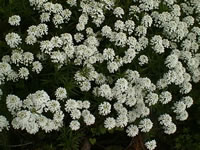Hyacinth-Flowererd Candytuft, Iberis amara, is a cool weather, fast growing
annual plant that grows 6"-18" tall and will spread to about 6". It has small, lance shaped green leaves and produces slightly rounded, 4"-6" clusters of fragrant white, pink or lavender tinged flowers from early spring into the summer.
Gibraltar Candytufts, Iberis gibraltarica, are sprawling, bushy perennials that grow to about 12" tall, with narrow, dark green leaves. They produce 2" clusters of pink or red-tinged white flowers during the summer.
Hardy in USDA zones 7-11
Iberis pruitii are short lived perennial plants that grow about 6" tall and will spread to about 8". They have dark green, slightly fleshy, rosette forming leaves and produce tight clusters of white to light violet colored flowers in the summer.
Hardy in USDA zones 7-11
Evergreen Candytuft, Iberis sempervirens, are woody, 6"-12" tall sub-shrubs that will spread to about 18"-24". They have glossy, dark green, 1½" leaves and produce 1½"-2" clusters of white, unscented flowers during the spring and early summer. Prune immediately after blooming.
Hardy in USDA zones 4-11
Globe Candytuft, Iberis umbellata, are mound forming, 10", cool weather annual plants that cover themselves with flattened 2" clusters of brightly colored, fragrant flowers in shades of red, white, pink or purple in late spring and early summer. Trim lightly after blooming.


